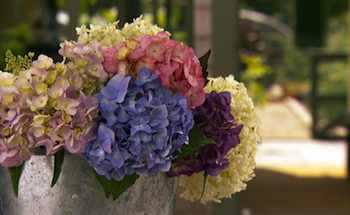By Sean Conway

Hydrangeas: Rhapsody in Blue -- or Cream or Pink
The billowy flower heads of the hydrangea come in a wide array of colors ranging from blue to pink to creamy white. The pH of the soil determines whether these attractive shrubs bear blue or pink flowers.
If you love blue flowers in your garden, few plants offer as many shades of this elusive color as hydrangeas. These reliable midsummer blooming shrubs for the most part require no care, and if a few simple cultural requirements are met they will bloom reliably in the garden for years.
Hybridizers from North America, Europe and Asia have been breeding this versatile shrub for years, and new varieties arrive on the market annually. The most recent breakthroughs in breeding have been in the area of containerized hydrangeas -- what professional growers call "florist hydrangeas." These plants are often available around the holidays and are found in beautiful shades of blue, pink, white and bi-colors. They often have large flowers that last for a long time indoors.
Hydrangeas prefer a moist, well-drained soil, and do best when planted in locations that receive sun in the morning but are shaded from the hot afternoon sun. They also benefit from periodic watering during hot dry spells.
Flower color in hydrangeas is influenced by the presence of aluminum, as well as soil pH.
In order for flowers to be blue, the plant must have access to aluminum. If the soil naturally contains aluminum, the pH must be slightly acidic for the plants to access it. A range of 5.1 to 5.5 is ideal. To get the bluest hydrangeas possible, a solution of 1 tablespoon of aluminum sulfate per gallon of water can be applied to plants throughout the growing season. To avoid burning the roots, be sure to water plants well before applying solution.
When the pH is raised to a range of 6.0 to 6.2, hydrangeas will turn pink, as the bluing effect of the aluminum is locked up in the soil. If pink flowers are desired, adding dolomitic lime to soil several times per year will raise the soil pH. Take care not to raise the soil pH above 6.4, as an iron deficiency may occur that will turn the plant's leaves yellow.
Pruning hydrangeas can be confusing to some gardeners. A few simple tips will keep your plants in check and still provide an abundance of blooms.
First know what type hydrangea you have.
There are many different types, and their forms range from small shrubs to small trees. Flower color ranges from blue and purple to pink and near red to white and cream. Your local garden center can help you determine which type you have.
Most blue hydrangeas are either "mopheads," named after their round billowy flowers, or "lacecaps," named for their flat delicate flower heads. Both mophead and lacecap hydrangeas bloom on stems formed the previous season.
Start your pruning by removing all dead stems.
If you are unsure which stems are alive, just wait until growth has begun in the spring, or scratch the stem and look for green bark just under the surface. Stems with leaves sprouting from the sides are last season's stems and will bloom this year. Pruning them will remove this season's flowers; so don't cut them just yet.
After the shrub has finished blooming, cut back the plant back by one third. Be sure to do this before mid-July, as the plant will need time to start forming buds for next year.
A notable exception is the mophead hydrangea called 'Endless Summer,' which blooms on new growth each season and can be cut back in the fall or early spring without diminishing the number of flowers produced.
© Sean Conway
AUTOS | HOBBIES | EDUCATION | FAMILY | FASHION | FOOD & RECIPES | HOME DECOR | RELATIONSHIPS | PARENTING | PETS | TRAVEL | WOMEN
Home & Garden - Hydrangeas Offer Impressive Palette to Gardener